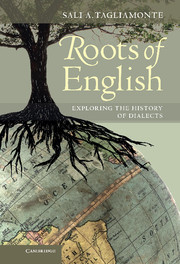Book contents
- Frontmatter
- Contents
- List of Figures
- List of Tables
- Preface
- Acknowledgements
- Abbreviations
- 1 Introduction
- 2 Dialects as a window on the past
- 3 The Roots Archive
- 4 Methods of analysis
- 5 Word endings
- 6 Joining sentences
- 7 Time, necessity and possession
- 8 Expressions
- 9 Comparative sociolinguistics
- 10 The legacy of British and Irish dialects
- Notes
- References
- Index
8 - Expressions
Published online by Cambridge University Press: 05 November 2012
- Frontmatter
- Contents
- List of Figures
- List of Tables
- Preface
- Acknowledgements
- Abbreviations
- 1 Introduction
- 2 Dialects as a window on the past
- 3 The Roots Archive
- 4 Methods of analysis
- 5 Word endings
- 6 Joining sentences
- 7 Time, necessity and possession
- 8 Expressions
- 9 Comparative sociolinguistics
- 10 The legacy of British and Irish dialects
- Notes
- References
- Index
Summary
Shall I tell you that broad Yorkshire farmer’s expression? It’s not rude. It’s an old Yorkshire farmer’s expression. ‘If a fella met a fella in a fella’s field could he tell a fella what a fella means?’ Have you heard of that one? It’s a conundrum, isn’t it.
(Daisy Smith, 69, YRK)In this chapter I examine features that involve adverbs. An adverb is any word that modifies other words, including verbs, adjectives, clauses, sentences and even other adverbs (but not nouns). An interesting fact about adverbs is that they are not always realized as a single word, but also include phrases and clauses. Adverbs, adverbial phrases and clauses are identifiable by the fact that they often answer questions such as ‘how?’, ‘in what way?’, ‘when?’, ‘where?’ and ‘to what extent?’ This is why they are often called ‘expressions’.
Adverbs and adverbial expressions are perhaps the most popular features of language because they are the most obvious in running discourse between people. Expressions can encompass ‘proverbs’ or ‘sayings’, a term used to describe any habitual expression of wisdom or truth, as in the proverb recounted above, and in the sayings in (1).
Information
- Type
- Chapter
- Information
- Roots of EnglishExploring the History of Dialects, pp. 161 - 184Publisher: Cambridge University PressPrint publication year: 2012
